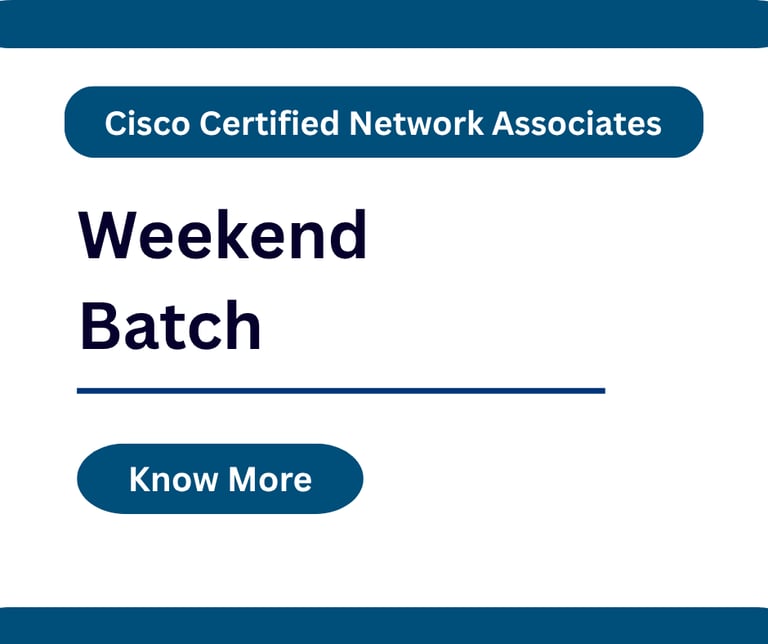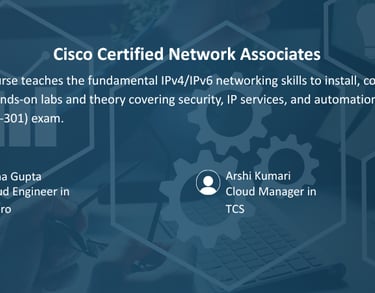







Major Industry Recruiters








Major Industry Recruiters
Course Description:
This comprehensive course provides the foundational knowledge and hands-on skills necessary to install, operate, configure, and verify a basic IPv4 and IPv6 network. It is designed to prepare students for the official Cisco Certified Network Associate (200-301 CCNA) exam, an industry-recognized certification that validates associate-level expertise in networking.
Through a mix of theory and practical labs using Cisco technologies, students will develop competencies across core networking concepts, security, network access, IP connectivity, IP services, and the fundamentals of automation and programmability. The course supports career roles such as Entry-Level Network Engineer, Network Administrator, and Help Desk Technician.
Course Objective:
Upon successful completion of this CCNA (200-301) training program, students will be equipped with the knowledge and hands-on skills to:
1. Core Network Implementation & Addressing
Configure and verify foundational network components, including routers, Layer 2/3 switches, and access points, to establish basic IPv4 and IPv6 network connectivity.
Apply proper IPv4 subnetting (FLSM/VLSM) and IPv6 addressing schemes to efficiently manage network address space.
Explain the function of different network components and compare various network architectures (two-tier, three-tier, spine-leaf).
2. Network Access Control & Redundancy
Implement and Troubleshoot Virtual Local Area Networks (VLANs) and 802.1Q trunking to segment the network and enable inter-VLAN routing.
Configure and verify Layer 2 redundancy protocols (e.g., RSTP PortFast) and link aggregation (EtherChannel LACP) to ensure high network availability.
Perform basic configuration of a Wireless LAN (WLAN) using the Wireless LAN Controller (WLC) GUI.
3. IP Routing and Traffic Forwarding
Configure and verify both static and floating static routes for both IPv4 and IPv6 networks (default, host, and network routes).
Implement and Troubleshoot single-area OSPFv2 to establish dynamic routing capabilities.
Interpret the components of a routing table and explain router forwarding decisions (e.g., Longest prefix match, Administrative Distance).
4. Essential IP Services and Management
Configure and Verify Network Address Translation (NAT), specifically Static, Dynamic, and Port Address Translation (PAT).
Implement best practices for device management, including configuring Secure Shell (SSH) for remote access and utilizing core services like DHCP, DNS, SNMP, and Syslog for network operations and monitoring.
Explain the role of Quality of Service (QoS) by describing the forwarding Per-Hop Behavior (PHB).
5. Network Security
Configure and verify standard and extended IPv4 Access Control Lists (ACLs) to filter and control network traffic flow.
Apply Layer 2 security features, such as Port Security, to mitigate access layer threats.
Implement basic device hardening steps, including password protection and understanding Authentication, Authorization, and Accounting (AAA) concepts.
Describe the key concepts of remote access and site-to-site VPNs.
6. Automation and Programmability
Compare and contrast traditional network architectures with Software-Defined Networks (SDN) and controller-based designs.
Demonstrate an understanding of configuration management mechanisms (e.g., Puppet, Chef, and Ansible) and the characteristics of REST-based APIs.
Interpret data encoded in formats like JSON.
Course Module:
The course content is structured around the six key domains of the CCNA 200-301 exam:
1. Network Fundamentals (Approx. 20% of content)
Network Components & Topologies: Role and function of routers, L2/L3 switches, firewalls, and access points. Comparison of two-tier, three-tier, and spine-leaf architectures.
Models: OSI and TCP/IP models, comparison of TCP and UDP.
Cabling & Media: Types of physical interfaces, cabling (copper, fiber), and common interface/cable issues (collisions, duplex/speed mismatch).
IP Addressing: Configuring and verifying IPv4 addressing and subnetting (FLSM/VLSM). Introduction to IPv6 addressing, prefixes, and address types.
Wireless Principles: Non-overlapping channels, SSID, RF, and basic encryption methods.
Virtualization: Fundamentals of server virtualization, containers, and VRFs.
2. Network Access (Approx. 20% of content)
Switched Networks: Switching concepts, MAC address learning/aging, frame switching.
VLANs and Trunks: Configuring and verifying VLANs and interswitch connectivity using trunk ports (802.1Q) and the native VLAN.
Layer 2 Redundancy: Interpreting the basic operation of Rapid PVST+ Spanning Tree Protocol (RSTP) and configuring features like PortFast.
Link Aggregation: Configuration and verification of Layer 2/Layer 3 EtherChannel (LACP).
Wireless LAN (WLAN): Cisco Wireless Architectures, AP modes, and basic configuration of WLAN using the WLC GUI.
3. IP Connectivity (Approx. 25% of content)
Routing Fundamentals: Interpreting the components of a routing table and router forwarding decisions (Longest prefix match, Administrative distance, Metric).
Static Routing: Configuring and verifying IPv4 and IPv6 static routing, including default, network, host, and floating static routes.
Dynamic Routing: Configuring and verifying single area OSPFv2 (neighbor adjacencies, point-to-point, broadcast, Router ID).
First Hop Redundancy Protocols (FHRP): Describing the purpose and concepts of FHRP (e.g., HSRP, VRRP).
4. IP Services (Approx. 10% of content)
Network Address Translation (NAT): Configuration and verification of NAT (Static, Dynamic, and PAT).
Core Services: Describing the roles and functions of DHCP (client/relay) and DNS within the network.
Device Management: Configuring network devices for remote access using SSH, and describing the capabilities of TFTP/FTP.
Monitoring: Describing the functions of SNMP and Syslog, and configuring NTP.
Quality of Service (QoS): Explaining the forwarding Per-Hop Behavior (PHB).
5. Security Fundamentals (Approx. 15% of content)
Security Concepts: Key security concepts (threats, vulnerabilities, exploits) and elements of a security program.
Access Control: Configuring and verifying Access Control Lists (ACLs) for network traffic filtering.
Layer 2 Security: Configuring Layer 2 security features like Port Security.
Device Hardening: Implementing basic steps to secure device access (passwords, login banners) and using authentication, authorization, and accounting (AAA) concepts.
VPNs: Describing the concepts of remote access and site-to-site VPNs.
6. Automation and Programmability (Approx. 10% of content)
Network Management: Comparing traditional networks with controller-based and Software-Defined Architectures (SDN).
APIs and Protocols: Describing the characteristics of REST-based APIs (CRUD, HTTP verbs, and data encoding).
Configuration Management: Recognizing the capabilities of configuration management mechanisms (Puppet, Chef, and Ansible).
Data Formats: Interpreting JSON-encoded data.
Course Overview:
The CCNA course is a deep dive into the essentials of modern networking infrastructures. It focuses on the practical application of networking concepts in small to medium-sized enterprise networks, emphasizing Cisco's leading-edge solutions.
Goal: To equip students with the skills required to manage and optimize network systems and successfully pass the CCNA 200-301 certification exam.
Key Skills Developed: Network component configuration (routers, switches, WLCs), IP addressing and subnetting, secure network management, troubleshooting, and initial exposure to network automation tools.
Methodology: Instructor-led lectures, extensive practical lab exercises using Cisco Packet Tracer or physical equipment, and real-world scenario analysis.
Prerequisites (Recommended): Basic computer literacy, familiarity with PC operating systems, and a conceptual understanding of network fundamentals are beneficial but not strictly mandatory.

Upcoming Batches: Choose as per Your Requirement




Our Mentors:
Richa Gupta
Cloud Engineer in Wipro
Arshi Kumari
Cloud Manager in TCS
Ahmed Khan
Cloud Engineer in Cognizant
Abhishek Singh
Cloud Engineer in IBM
Our Mentors:
Richa Gupta
Cloud Engineer in Wipro
Aina Rathor
DevOps Engineerex-Deloitte
Ahmed Khan
Coud Engineer in Cognizant
Coud Engineer in IBM
Abhishek Singh
Our Alumni Work at Top Companies
FAQs – Cisco Certified Network Associates at GIMIT
1) What is the Cisco Certified Network Associate (CCNA) course?
The CCNA course is a comprehensive training program designed to equip you with the foundational knowledge and hands-on skills required to install, operate, configure, and verify basic IPv4 and IPv6 networks using Cisco technologies.
2) What level of professional is this course designed for?
This course is ideal for individuals aiming for entry-level networking roles such as Network Administrator, Entry-Level Network Engineer, or Help Desk Technician. It provides the core expertise needed to start a career in IT networking.
3) What are the recommended prerequisites for enrolling?
While there are no strict formal prerequisites from Cisco, it is beneficial to have basic computer literacy, familiarity with PC operating systems, and a conceptual understanding of network fundamentals.
4) Does this course prepare me for the official certification exam?
Yes, this course is specifically structured to prepare students for the official Cisco Certified Network Associate (200-301 CCNA) exam, covering all six of its core domains.
5) What hands-on experience will I gain during the training?
You will gain extensive practical experience through hands-on labs utilizing tools like Cisco Packet Tracer (or physical equipment) and real-world scenario analysis, focusing on configuring network components (routers, switches, WLCs).
6) Which core networking domains are covered in the curriculum?
The course covers all key CCNA domains: Network Fundamentals, Network Access, IP Connectivity, IP Services, Security Fundamentals, and Automation & Programmability.
7) What key technical skills will I develop by the end of the course?
You will develop competencies in IP addressing and subnetting, configuration of routing and switching protocols (like OSPFv2, VLANs, and RSTP), secure network management, troubleshooting, and introductory network automation techniques.
8) How is network automation integrated into this course?
The course introduces the fundamentals of Automation and Programmability, including a comparison of traditional vs. Software-Defined Architectures (SDN), REST-based APIs, configuration management tools (Puppet, Ansible), and interpreting JSON data.
9) Will this certification help my career?
Yes, the CCNA certification is an industry-recognized credential that validates your expertise and is highly valued by employers, significantly boosting your profile for associate-level networking job roles.
10) Do I need to be familiar with Cisco Packet Tracer beforehand?
No prior deep familiarity is required. The course's methodology includes extensive practical lab exercises where you will learn to use Cisco technologies and tools like Packet Tracer as part of the curriculum.





